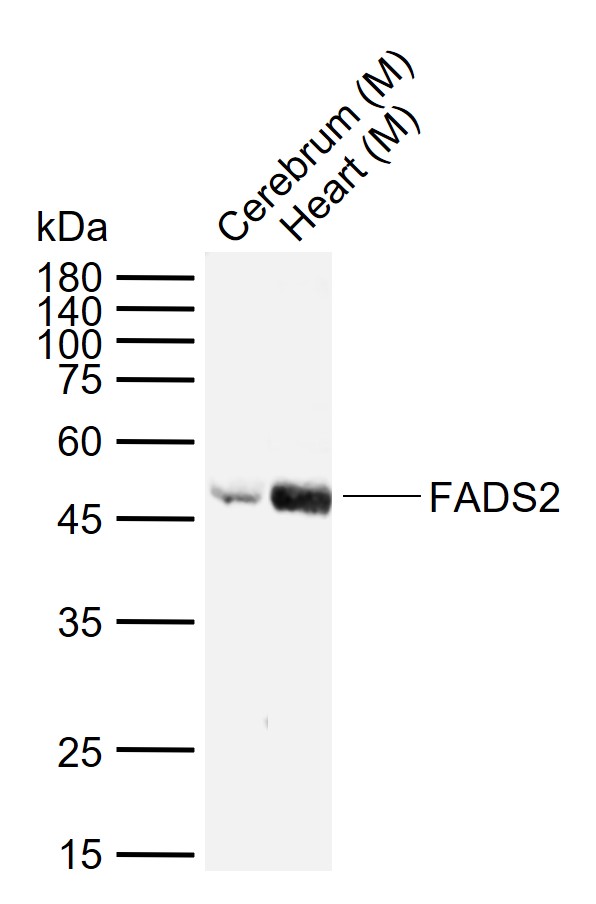
Rabbit Anti-FADS2 antibody
D6D; Delta(6) desaturase; Delta(6) fatty acid desaturase; DES 6; DES6; FADS 2; FADSD 6; FADSD6; Fatty acid desaturase 2; linoleoyl-CoA desaturase (delta-6-desaturase) like 2; LLCDL 2; LLCDL2; SLL0262; TU 13; TU13; FADS2_HUMAN.
View History [Clear]
Details
Product Name FADS2 Chinese Name 脂肪酸脱氢酶2抗体 Alias D6D; Delta(6) desaturase; Delta(6) fatty acid desaturase; DES 6; DES6; FADS 2; FADSD 6; FADSD6; Fatty acid desaturase 2; linoleoyl-CoA desaturase (delta-6-desaturase) like 2; LLCDL 2; LLCDL2; SLL0262; TU 13; TU13; FADS2_HUMAN. literatures Research Area Tumour Cardiovascular immunology Neurobiology Kinases and Phosphatases Immunogen Species Rabbit Clonality Polyclonal React Species Mouse, (predicted: Human, Rat, Chicken, Pig, Cow, Horse, Rabbit, ) Applications WB=1:500-2000 ELISA=1:5000-10000 IHC-P=1:100-500 IHC-F=1:100-500 ICC=1:100-500 IF=1:100-500 (Paraffin sections need antigen repair)
not yet tested in other applications.
optimal dilutions/concentrations should be determined by the end user.Theoretical molecular weight 52kDa Cellular localization cytoplasmic The cell membrane Form Liquid Concentration 1mg/ml immunogen KLH conjugated synthetic peptide derived from human FADS2: 221-300/444 Lsotype IgG Purification affinity purified by Protein A Buffer Solution 0.01M TBS(pH7.4) with 1% BSA, 0.03% Proclin300 and 50% Glycerol. Storage Shipped at 4℃. Store at -20 °C for one year. Avoid repeated freeze/thaw cycles. Attention This product as supplied is intended for research use only, not for use in human, therapeutic or diagnostic applications. PubMed PubMed Product Detail Members of the fatty acid desaturase (FADS) family, including FADS1, FADS2 and FADS3, regulate the desaturation of fatty acids by introducing double bonds between defined carbons of fatty acyl chains, thereby playing an essential role in the lipid metabolic pathway. Members of this family share N-terminal cytochrome b5-like domains, C-terminal multiple membrane-spanning desaturase regions and 3 histidine box motifs. FADS2 (fatty acid desaturase 2), also known as D6D, DES6, LLCDL2 or TU13, is a 444 amino acid multi-pass membrane protein that localizes to the endoplasmic reticulum and contains one cytochrome b5 heme-binding domain. Expressed in adult and fetal heart and in adult liver, brain, lung and retina, FADS2 functions as a component of a lipid metabolic pathway and catalyzes the first step in the pathway, namely the formation of unsaturated fatty acids from polyunsaturated fatty acids. Defects in the gene encoding FADS2 are the cause of cause of fatty acid delta-6-desaturase deficiency, an affliction that is characterized by skin abnormalities, corneal ulceration and growth failure. Multiple isoforms of FADS2 exist due to alternative splicing events.
Function:
FADS2 (Fatty acid desaturase 2) catalyses the biosynthesis of highly unsaturated fatty acids from precursor essential polyunsaturated fatty acids (linoleic and alpha-linoleic acid). FADS family members comprise an N-terminal cytochrome b5-like domain and a C-terminal membrane-spanning desaturase. FADS2 is repressed by dietary highly unsaturated fatty acids. Altered expression of FADS2 may be associated with obesity-associated insulin resistance. Genetic studies have linked FADS2 to IQ and attention-deficit/hyperactivity disorder (ADHD).
Subcellular Location:
Endoplasmic reticulum membrane; Multi-pass membrane protein
Tissue Specificity:
Expressed in a wide array of tissues, highest expression is found in liver followed by brain, lung, heart, and retina. A lower level is found in breast tumor when compared with normal tissues; lowest levels were found in patients with poor prognostic index.
Similarity:
Belongs to the fatty acid desaturase family.
Contains 1 cytochrome b5 heme-binding domain.
SWISS:
O95864
Gene ID:
9415
Database links:Entrez Gene: 9415 Human
Entrez Gene: 56473 Mouse
Omim: 606149 Human
SwissProt: Q4R749 Cynomolgus monkey
SwissProt: O95864 Human
SwissProt: Q9Z0R9 Mouse
SwissProt: Q5REA7 Orangutan
Unigene: 502745 Human
Unigene: 38901 Mouse
Unigene: 162483 Rat
Product Picture
Bought notes(bought amounts latest0)
No one bought this product
User Comment(Total0User Comment Num)
- No comment



 +86 571 56623320
+86 571 56623320
 +86 18668110335
+86 18668110335

